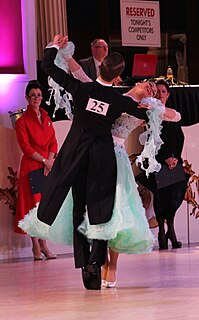 W
WBallroom dance is a set of partner dances, which are enjoyed both socially and competitively around the world. Because of its performance and entertainment aspects, ballroom dance is also widely enjoyed on stage, film, and television.
 W
WFred Astaire Dance Studios, Inc. is a ballroom dance franchise chain of studios in the United States and Canada, named after and co-founded by famous dancer Fred Astaire. It is headquartered in Longmeadow, Massachusetts, USA.
 W
WThe 8-day Blackpool Dance Festival is the world's first and most famous annual ballroom dance competition of international significance, held in the Empress Ballroom at the Winter Gardens, Blackpool, England since 1920. It is also the largest ballroom competition: in 2013, 2953 couples from 60 countries took part in the festival.
 W
WThe BYU Ballroom Dance Company originates in the Department of Dance of the College of Fine Arts and Communications at Brigham Young University (BYU) in Provo, Utah. It has been a part of BYU for nearly 50 years and competes and performs throughout the world.
 W
WCastle Walk is a dance originated and made famous by Vernon and Irene Castle. The Castle Walk became popular through its introduction into the Tango. "Castle Walk" is also a popular American song (©1914) composed for Vernon and Irene Castle by James Reese Europe (1880–1919) and Ford Thompson Dabney (1983–1958). It was first recorded in 1914.
 W
WThe cha-cha-cha, is a dance of Cuban origin. It is danced to the music of the same name introduced by Cuban composer and violinist Enrique Jorrin in the early 1950s. This rhythm was developed from the danzón-mambo. The name of the dance is an onomatopoeia derived from the shuffling sound of the dancers' feet when they dance two consecutive quick steps that characterize the dance.
 W
WThe Champion Ballroom Academy is a dance studio in San Diego, California. The studio's main specialties are social partner-dancing, competitive ballroom dance and the Latin-dance-based aerobic program called Core Rhythms.
 W
WThe Charleston is a dance named after the harbor city of Charleston, South Carolina. The rhythm was popularized in mainstream dance music in the United States by a 1923 tune called "The Charleston" by composer/pianist James P. Johnson, which originated in the Broadway show Runnin' Wild and became one of the most popular hits of the decade. Runnin' Wild ran from October 28, 1923, through June 28, 1924. The peak year for the Charleston as a dance by the public was mid-1926 to 1927.
 W
WDancesport is competitive ballroom dancing, as contrasted to social or exhibition dancing. In the case of wheelchair dancesport, at least one of the dancers is in a wheelchair.
 W
WDancing Brasil is a Brazilian reality television series based on the ABC celebrity dance competition Dancing with the Stars, produced by Endemol Shine in partnership with BBC Worldwide.
 W
WDancing with the Stars is an American dance competition television series that premiered on June 1, 2005, on ABC. It is the US version of the UK series Strictly Come Dancing, and one of several iterations of the Dancing with the Stars franchise. The show was first hosted by Tom Bergeron from its inception until 2019. Lisa Canning was co-host in the first season, Samantha Harris co-hosted seasons two through nine, Brooke Burke-Charvet in seasons ten through seventeen, and Erin Andrews from season eighteen through twenty-eight. The show was renewed for its twenty-ninth season which premiered on September 14, 2020 with the addition of new host Tyra Banks, replacing Bergeron.
 W
WDancing with the Stars: Juniors is an American children's dance competition television series that premiered on October 7, 2018 on ABC. It is a spin-off of the Dancing with the Stars series. The format of the show features celebrity children paired with professional junior ballroom dancers and mentored by an adult professional dancer. The couples compete against each other by performing choreographed dance routines in front of a panel of judges. In September 2019, ABC decided to cancel the series after one season.
 W
WThe English Amateur Dancesport Association (EADA) Ltd is a volunteer-led organisation which represents the interests of Amateur Dancers within England. EADA provides support and training for Amateur dancers and acts as the voice of English Amateur dancers amongst other dance organisations both in the UK and overseas. EADA also aims to get the younger audience involved and on the dance floor. EADA hopes to increase the profile of dancesport.
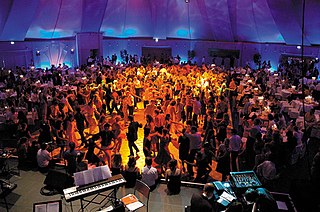 W
WEuro Dance Festival is a dance festival in Europe attracting about 5,000 visitors in 2010. The festival is best known for its wide range of music and dancing styles. These are Ballroom Dance, Argentine Tango, Swing Dance, Hip Hop and Breakdance. A combination of dancing classes and shows and a trade fair caters to the needs of both beginners and professionals including dance instructors and choreographers. Since its foundation in 2007, it has taken place for four days every year in early spring.
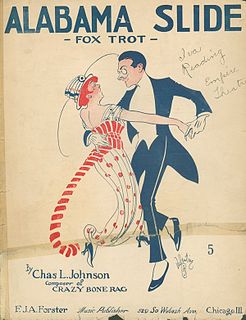 W
WThe foxtrot is a smooth, progressive dance characterized by long, continuous flowing movements across the dance floor. It is danced to big band music. The dance is similar in its look to waltz, although the rhythm is in a 44 time signature instead of 34. Developed in the 1910s, the foxtrot reached its height of popularity in the 1930s and remains practiced today.
 W
WWaltz is one of the five dances in the Standard category of the International Style ballroom dances. It was previously referred to as slow waltz or English waltz.
 W
WThe jive is a dance style that originated in the United States from African-Americans in the early 1930s. The name of the dance, jive, comes from the name of a form of African-American Vernacular slang, popularized in the 1930s by the publication of a dictionary by Cab Calloway, the famous jazz bandleader and singer. In competition ballroom dancing, the jive is often grouped with the latin-inspired ballroom dances, though its roots are based on swing dancing and not latin dancing.
 W
WMambo is a Latin dance of Cuba which was developed in the 1940s when the music genre of the same name became popular throughout Latin America. The original ballroom dance which emerged in Cuba and Mexico was related to the danzón, albeit faster and less rigid. In the United States, it replaced rhumba as the most fashionable Latin dance. Later on, with the advent of salsa and its more sophisticated dance, a new type of mambo dance including breaking steps was popularized in New York. This form received the name of "salsa on 2", "mambo on 2" or "modern mambo".
 W
WMerengue is a style of Culture of the Dominican Republic music and dance. Partners hold each other in a closed position. The leader holds the follower's waist with the leader's right hand, while holding the follower's right hand with the leader's left hand at the follower's eye level. Partners bend their knees slightly left and right, thus making the hips move left and right. The hips of the leader and follower move in the same direction throughout the song. Partners may walk sideways or circle each other, in small steps. They can switch to an open position and do separate turns without letting go each other's hands or releasing one hand. During these turns they may twist and tie their handhold into intricate pretzels. Other choreographies are possible.
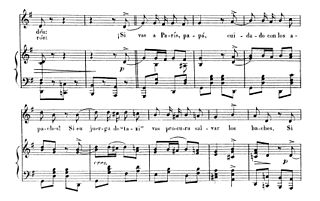 W
WThe One-Step was a ballroom dance popular in social dancing at the beginning of the 20th century.
 W
WPasodoble is a fast-paced Spanish military march used by infantry troops. Its speed allowed troops to give 120 steps per minute. This march gave rise to a traditional Spanish dance, a musical genre including both voice and instruments, and a genre of instrumental music often played during bullfight. Both the dance and the non martial compositions are also called pasodoble.
 W
WThe quickstep is a light-hearted dance of the standard ballroom dances. The movement of the dance is fast and powerfully flowing and sprinkled with syncopations. The upbeat melodies that quickstep is danced to make it suitable for both formal and informal events. Quickstep was developed in the 1920s in New York City and was first danced by Caribbean and African dancers. Its origins are in combination of slow foxtrot combined with the Charleston, a dance which was one of the precursors to what today is called swing dancing.
 W
WThe international ballroom version of samba is a lively, rhythmical dance with elements from Brazilian samba. It differs considerably from the original samba styles of Brazil; in particular, it differs from Samba de Gafieira, a partner type of Samba in that country.
 W
WStrictly Come Dancing is a British television dance contest in which celebrities partner with professional dancers to compete in mainly ballroom and Latin dance. Each couple is scored by a panel of judges. The title of the show is a continuation of the long-running series Come Dancing, with an allusion to the film Strictly Ballroom. The format has been exported to 60 other countries — under the title Dancing with the Stars — licensed by BBC Worldwide, and led to a modern dance-themed spin-off Strictly Dance Fever. The Guinness World Records has named Strictly to be the world's most successful reality television format. The series is currently presented by Tess Daly and Claudia Winkleman.
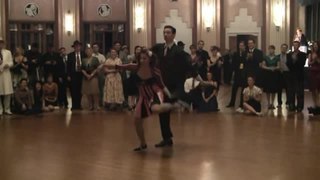 W
WSwing dance is a group of dances that developed with the swing style of jazz music in the 1920s–1940s, with the origins of each dance predating the popular "swing era". Hundreds of styles of swing dancing were developed; those that have survived beyond that era include Lindy Hop, Balboa, Collegiate Shag, and Charleston. Today, the best-known of these dances is the Lindy Hop, which originated in Harlem in the early 1930s. Swing dances began in African American communities as vernacular African American dances.
 W
WViennese waltz is a genre of ballroom dance. At least four different meanings are recognized. In the historically first sense, the name may refer to several versions of the waltz, including the earliest waltzes done in ballroom dancing, danced to the music of Viennese waltz.
 W
WVogue, or voguing, is a highly stylized, modern house dance originating in the late 1980s that evolved out of the Harlem ballroom scene of the 1960s. It gained mainstream exposure when it was featured in Madonna's song and video "Vogue" (1990), and when showcased in the 1990 documentary Paris Is Burning. In its modern form, this dance has become a global phenomenon that continues to evolve both stylistically and demographically.
 W
WKlaipėda University DSC Žuvėdra is a dancesport formation dance team since 1995 affiliated with Klaipėda University, Klaipėda, Lithuania. It is a 7-time world champion and 9-time European champion. It was founded in 1965 by ballroom dancer Ona Skaistutė Idzelevičienė. She and her husband Romaldas Idzelevičius are the primary trainers.